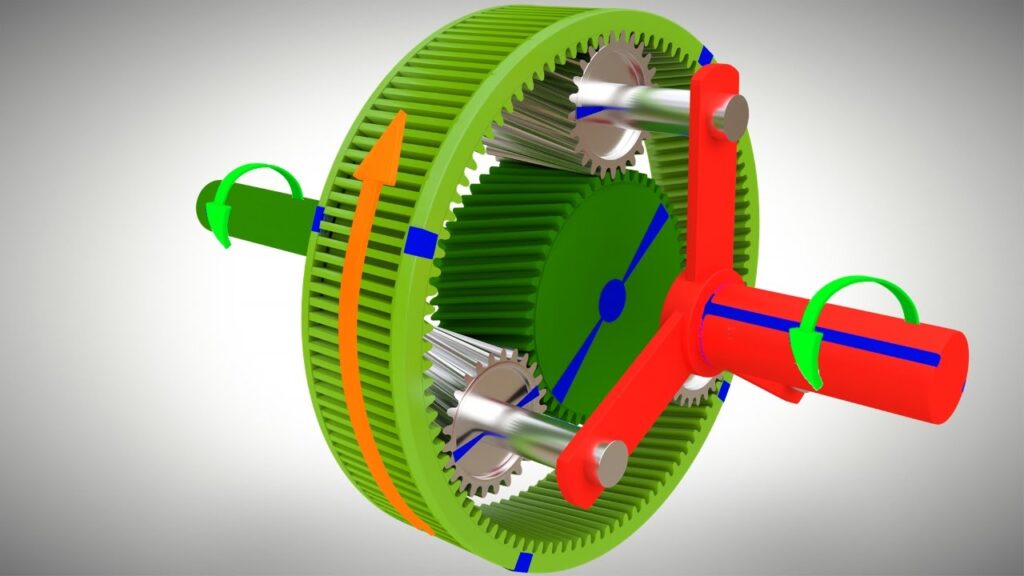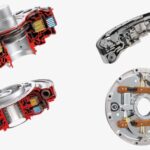The planetary gear set is the device that produces different gear ratios through the same set of gears. Any planetary gear set has three main components:
· The sun gear
· The planet gears and the planet gears’ carrier
· The ring gear
Each of these three components can be the input, the output or can be held stationary. Choosing which piece plays which role determines the gear ratio for the gear set.
Compound Planetary gear set – The automatic transmission uses a set of gears, called a compound planetary gear set that looks like a single planetary gear set but actually behaves like two planetary gear sets combined. It has one ring gear that is always the output of the transmission, but it has two sun gears and two sets of planets.
The figure below shows a compound planetary gear set:

First Gear– In first gear, the smaller sun gear is driven clockwise by the turbine in the torque converter. The planet carrier tries to spin counter clockwise, but is held still by the one-way clutch (which only allows rotation in the clockwise direction) and the ring gear turns the output. The small gear has 30 teeth and the ring gear has 72, so the gear ratio is:
Ratio = -R/S = – 72/30 = -2.4:1
So the rotation is negative 2.4:1, which means that the output direction would be opposite the input direction. But the output direction is really the same as the input direction — this is where the trick with the two sets of planets comes in. The first set of planets engages the second set, and the second set turns the ring gear; this combination reverses the direction. You can see that this would also cause the bigger sun gear to spin but because that clutch is released, the bigger sun gear is free to spin in the opposite direction of the turbine (counter clockwise).
Second Gear – The two planetary gear sets connected to each other with a common planet carrier.
The first stage of the planet carrier actually uses the larger sun gear as the ring gear. So the first stage consists of the sun (the smaller sun gear), the planet carrier, and the ring (the larger sun gear).
The input is the small sun gear; the ring gear (large sun gear) is held stationary by the band, and the output is the planet carrier. For this stage, with the sun as input, planet carrier as output, and the ring gear fixed, the formula is:
1 + R/S = 1 + 36/30 = 2.2:1
The planet carrier turns 2.2 times for each rotation of the small sun gear. At the second stage, the planet carrier acts as the input for the second planetary gear set, the larger sun gear (which is held stationary) acts as the sun, and the ring gear acts as the output, so the gear ratio is:
1 / (1 + S/R) = 1 / (1 + 36/72) = 0.67:1
To get the overall reduction for second gear, we multiply the first stage by the second, 2.2 x 0.67, to get a 1.47:1 reduction.
Third Gear– Most automatic transmissions have a 1:1 ratio in third gear. To achieve a ratio of 1:1 engage the clutches that lock each of the sun gears to the turbine. If both sun gears turn in the same direction, the planet gears lockup because they can only spin in opposite directions. This locks the ring gear to the planets and causes everything to spin as a unit, producing a 1:1 ratio.
Overdrive Gear– An overdrive has a faster output speed than input speed. When overdrive is engaged, a shaft that is attached to the housing of the torque converter (which is bolted to the flywheel of the engine) is connected by clutch to the planet carrier. The small sun gear freewheels, and the larger sun gear is held by the overdrive band. Nothing is connected to the turbine; the only input comes from the converter housing. This time with the planet carrier for input, the sun gear fixed and the ring gear for output.
Ratio = 1 / (1 + S/R) = 1 / (1 + 36/72) = 0.67:1
So the output spins once for every two-thirds of a rotation of the engine. If the engine is turning at 2000 rotations per minute (RPM), the output speed is 3000 RPM. This allows cars to drive at freeway speed while the engine speed stays nice and slow.
Reverse Gear– Reverse is very similar to first gear, except that instead of the small sun gear being driven by the torque converter turbine, the bigger sun gear is driven, and the small one freewheels in the opposite direction. The planet carrier is held by the reverse band to the housing. So, according to our equations from the last page, we have:
Ratio = -R/S = 72/36 = 2.0:1
So the ratio in reverse is a little less than first gear in this transmission.
Summary of Gear Ratios- Transmission having four forward gears and one reverse gear.


